C-7 Home Page
Celestron History
![]() C-7 News
C-7 News ![]() Consignment
Consignment ![]() Library
Library ![]() Products & Services
Products & Services ![]() Product Lines
Product Lines ![]() Order
Order ![]() Search C7.com
Search C7.com
![]() Distribution
Distribution ![]() News
News ![]() Notes & Interesting Articles
Notes & Interesting Articles ![]() Products
Products ![]() Pricing
Pricing ![]() Quality Assurance
Quality Assurance

Celestron NexStar® 11 GPS (2002 revision)
11" (28cm) "Fastar" Schmidt-Cassegrain Computer Controlled Telescope
When introduced by Celestron in year 2001 Company Seven elected not to offer the telescope. It was not until Celestron made several refinements and improvements to the model later in year 2002 that we elected to make the revised Nexstar 11 GPS telescope available. We suggest readers keep in mind the following data and specifications remain subject to change. Please contact Company Seven for more information.
Right: Celestron NexStar 11 GPS Telescope with field tripod. (85,089 bytes).
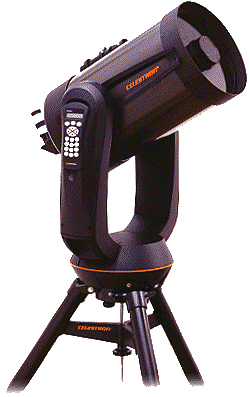
DEVELOPMENT
celestron/products/sch14.html The first limited deliveries of Celestrons first portable computer controlled telescope Ultima® 2000 began in August of 1996. Company Seven anticipated some larger derivative of this computer controlled telescope possibly in an 11" configuration would be made available, possibly in 1998 at the earliest. Since the introduction in August 1999 of the NexStar control system (first employed with the Celestron 5" telescope, but offered by Company Seven in the 8" configuration) it became more likely likely that a new 11" telescope would not be a simply upscaled "Ultima" series instrument. We anticipated this since it would require further improvements to the Nexstar concept to make it truly acceptable by the more demanding astronomers who seek telescopes such as the 11.Company Seven understood that the current production computer controlled telescopes are not exactly "idiot proof" since a knowledge of the sky and or the telescope geographic location was necessary in order to initialize these other telescopes. It was thought here that either Celestron or a competitor would "leapfrog" the other by incorporating an OEM "Global Positioning System" (hence "GPS") to help the user with the telescope set up process. Celestron International has become the first in the world to do this.
While waiting for Celestron to come up with a good "Go-To" C-11, Company Seven continued to offer computer controlled C-11 telescopes that are industrial in quality of performance and reliability. These are based on implementing the Celestron C-11 optical tube assembly onto the proven Astro-Physics or Losmandy computer controlled German Equatorial mounts. With the understanding that a telescope is comprised of two major components (optical tube assembly - OTA, a suitable mount, and numerous accessories), the concept of a German mount has advantages over the fork mounted designs in that:
- it is easier to properly balance a telescope on a German equatorial mount (particularly with accessories) than the Fork mount
- when working towards the celestial pole while using accessories such as CCD cameras with flip mirrors, etc. Fork mounts can bind the telescope and restrict movements
- the German mounts allow one to quickly interchange telescopes; one might use the C-11 on the German mount for observing or imaging small faint objects, and then later pull down the C-11 and slip on another telescope for coverage of wider fields of view.
- particularly in most consumer oriented computer controlled Fork mount Cassegrains of 10 inch and larger apertures, it is required that the owner to keep the optical tube attached onto the fork mount for transport. There is no way to quickly slip an OTA out of the Fork and later replace it maintaining proper alignment of the OTA to the Fork. This makes a telescope the size of a working Fork mounted C-11 weigh in typically at 60 lbs. (27.3 kg) to 75 lbs (34 kg). While the German system allows one to break down an instrument for transport into a number of components. Each component will weigh far less that the telescope would if installed onto a Fork mount, on a telescope such as our CG-11 where the Celestron C-11 OTA is mated to a Losmandy G-11 mount, then the heaviest single components may weight no more than 31 lbs (14 kg).
- the German equatorial mount with telescope can be taken down into components that are less bulky than an assembled fork mounted model. This is a real plus for people transporting the telescope in a small car or with little extra space in a loaded vehicle.
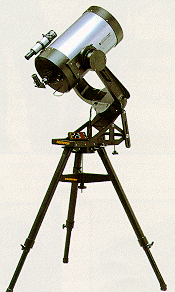 Right: Prototype of the Celestron "Ultima® 11" telescope with Field Tripod and Equatorial Wedge. This system was never put into production (30,618 bytes).
Right: Prototype of the Celestron "Ultima® 11" telescope with Field Tripod and Equatorial Wedge. This system was never put into production (30,618 bytes).
The Fork Mount however, does has advantages over the German equatorial designs that are particularly attractive to the novice:
- the fork mounted telescope will remain lighter in weight overall than most German mounts
- the fork mount will be quicker to set, up with fewer components to put together than a German mount
- for some the Fork mount is more intuitive, and therefore easier to use.
OPTICAL ARRANGEMENT
The C-11 is a relatively large aperture Schmidt-Cassegrain telescope providing a most excellent balance of versatility, transportability, and for many - price. This is perhaps the largest truly portable Schmidt-Cassegrain telescope system which can be easily set up and then operated by an individual of average height and weight. With 11" aperture, astronomical observing becomes easier than with smaller aperture telescopes as objects show much more detail and structure - this is the first telescope moving up the ladder of quality and size which can give one the impression of those first faint deep sky objects one will tend to search for ("Messier" catalog) that approximate those images shown in most observers handbooks. And when the time comes to take down the instrument at the end of a session (usually when the observer might be cold and sleepy) the easily manageable C-11 does not beat you to death.The Celestron 11" provides about 1.9X more light gathering power than a comparable 8" (20 cm) Schmidt-Cassegrain telescope, and 1.26X more than a 10" (25 cm) SC telescope. While the views of deep sky objects can be impressive (with Messier objects looking far more recognizable than the misty patch glimpsed with an 8"), the views of lunar and planetary detail are striking too. The tremendous aperture and good quality optics combine for thrilling "little imagination necessary" deep-sky observing or imaging of diffuse and planetary nebulae, open and globular star clusters, and galaxies. With a suitable Fork or German mount the system can be disassembled into components small enough to be easily carried or transported to remote sites for serious astronomical work. Experience scientific research quality optical performance which will provide pleasing views of the planets, moon, and of the faint "deep sky" objects including diffuse and planetary nebulae, open and globular clusters, galaxies, binary stars. In fact while many amateurs own the C-11 and its larger cousin the C-14, this too is a very popular choice for high school and college, occultation work, remote site surveys, and CCD imaging by University and research clients.
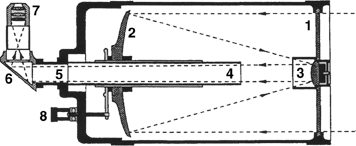 Left: Cross section illustration of Celestron 8" Schmidt-Cassegrain optical tube assembly, this is similar to the C-11 arrangement (20,116 bytes).
Left: Cross section illustration of Celestron 8" Schmidt-Cassegrain optical tube assembly, this is similar to the C-11 arrangement (20,116 bytes).
Light enters through the Corrector Lens (1), then is reflected from the perforated Primary Mirror (2) at the rear of the telescope tube forward to the Secondary Mirror (3).
Light is then reflected from the Secondary Mirror back through Primary Baffle Tube (4) beyond the Rear Cell (5). Illustration shows the Rear Cell with accessories attached: 90 degree Zenith Prism (6) (or Mirror) diagonal, and an Eyepiece (7). The current production C-11 include the 1.25" prism and with this accessory the image will be presented to the observer appearing right side up, but reversed left to right.
The Focus Control Knob (8) is rotated clockwise or counter clockwise to move the Primary Mirror forward towards, or to the rear away from the Corrector Lens and Secondary Mirror; this will adjust the position of the focal plane beyond the rear cell of the telescope optical tube assembly where an eyepiece for viewing or a camera for imaging are attached.
One would have to spend significantly more money to find other telescopes that could do or surpass what the SCT can do so reasonably well. Considering all of these attributes, Company Seven probably sells as many if not more C-11 telescopes as we do C-8's!
FASTAR
The Fastar system combines telescope design features with a suitable optional CCD camera to make it possible for a telescope to produce good imaging results with extremely short exposure times; these may be about 25 times faster than was otherwise possible at f10 or f11 prime focus. Fastar is a joint development of Celestron working with the Santa Barbara Instruments Group who are well regarded for their advancements in the field of CCD imaging technology. The Fastar system was originally announced in 1997 for the C-8 by Celestron, and it was offered beginning in September of 1998 for the Celestron C-14. The Fastar capability is featured on the Celestron Nexstar 11 telescope, and all C-11 OTA's sold separately since September 2002.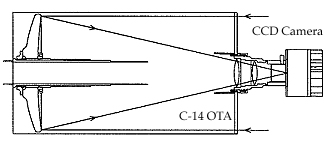 Above: Celestron Fastar CCD Camera Arrangement showing C-14 Optical Tube at left, with CCD Camera attached in Secondary Mirror position (20,355 bytes). |
These Fastar equipped telescopes incorporate a machined Secondary Mirror Holder with thread on retaining ring instead of the original plastic holder that was formerly cemented onto the Corrector Lens. The assembly can be easily removed by the user in the field - with no tools being required to do so. The standard Secondary Mirror Holder with Secondary Mirror attached can now be removed, and then interchanged with an optional Fastar Field Flattening Lens Set which includes the CCD camera holder. Even when the Secondary Mirror Holder with its Secondary Mirror are put back into place on the telescope, the hardware has an indexing pin and is mechanically well made so that the optical collimation of the system is retained.
On the C-11 with a Fastar CCD camera is capable of imaging fields of view of up to 0.35 x 0.46 degrees - this is the equivalent of using the telescope as a 587mm f1.9 lens! Compare this to the 35mm film coverage at f10 of 0.7 x 0.5 degrees. The Fastar telescope retains its full visual capabilities at f11, and can also will accommodate a variety of optional lenses at the axial port to vary the effective focal length and f ratio as fast as f3.
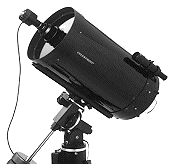
Left: Celestron C-14 on optional German Equatorial Mount, with Fastar compatible CCD camera attached (16,334 bytes).
The Fastar system is engineered to be compatible only with certain specific CCD cameras including the Celestron Pixcel 255 and Pixcel 237, and the SBIG Model ST-5 and ST-237 series. In addition, Company Seven offers optional Color Filter Wheel magazines for tricolor imaging for several of these compatible CCD cameras.
CELESTRON'S ANNOUNCEMENT
Celestron's initial announcement of the telescope was released on 19 January 2001:"The NexStar 11 GPS is the culmination of years of engineering research and development delivering the ultimate instrument in Go-To technology and astro imaging. This large aperture telescope with carbon fiber tube is the first instrument of it's kind to boast an integrated Global Positioning System and electronic compass, combined with the NexStar system, which makes this the most advanced telescope on the market.
It's so advanced that as you turn it on, the integrated GPS and compass system automatically pinpoints your exact location and points to your first alignment star. No need to enter the date, time, longitude and latitude or even know the position of north.
Also new is our advanced Tour Function "search engine" that allows you to create your own customized Tours.Ê This tour feature will search the database for any object above the horizon based on the users search criteria and generate a custom list of fascinating objects to view.
The NexStar 11 GPS is the most advanced, easiest to use telescope we've ever designed. It's the ultimate large aperture, portable telescope.
NexStar 11 Specifications:
Optical:
- 279mm (11") Diameter Schmidt-Cassegrain
- Focal Length of 2800mm
- Focal Ratio of f/10
- Fastar f1.9 compatible
- Made in the U.S.A.
- 50,000+ object database
- Flash Memory - allows software upgrades via the Internet
- Storage for numerous user-defined objects
- Database search engine to create custom Tours
Electronics:
- Computerized hand control with backlit, dual line liquid crystal display (LCD).
- Permanent Periodic Error Correction - Permanently saves and plays back corrections to reduce periodic error to a minimum.
- Designated Autoguider port
- RS232 compatible PC port
- Auxiliary ports for add-on NexStar accessories
- Dual aluminum fork arms with carrying handles and hand control receptacle.
- 5.625" 180 tooth precision worm gear on both axes
- 9.5" friction roller bearing
- 16 bit, 20 arc second resolution
- Fastar compatible optical tube for F/2 CCD imaging
- Adjustable height tripod
- Telescope weight: 65 lbs.
- Tripod weight: 26 lbs.
- Made in the U.S.A.
- Premium 40mm (70x) 1-1Ú4" Plossl Eyepiece
- 9x50 Finderscope
- Prism Star Diagonal, 1-1Ú4"
- Visual Back/Accessory Holder, 1-1Ú4"
- 115V AC adapter
- Adjustable Height Heavy Duty Field Tripod
- Computer Hand Control for Go-To Tracking with over 50,000 Object Database
- RS-232 Port to communicate with a PC
- Nine Available Slew Speeds
Celestron Schmidt-Cassegrain Telescopes
Go to Price List
Go back to Celestron Products page
Contents Copyright 1994-2001 Company Seven - All Rights Reserved

